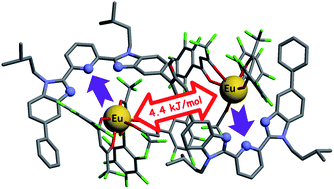当前位置:
X-MOL 学术
›
Chem. Sci.
›
论文详情
Our official English website, www.x-mol.net, welcomes your
feedback! (Note: you will need to create a separate account there.)
Cooperative loading of multisite receptors with lanthanide containers: an approach for organized luminescent metallopolymers†
Chemical Science ( IF 7.6 ) Pub Date : 2017-11-06 00:00:00 , DOI: 10.1039/c7sc03710d Lucille Babel 1 , Laure Guénée 2 , Céline Besnard 2 , Svetlana V Eliseeva 3 , Stéphane Petoud 3 , Claude Piguet 1
Chemical Science ( IF 7.6 ) Pub Date : 2017-11-06 00:00:00 , DOI: 10.1039/c7sc03710d Lucille Babel 1 , Laure Guénée 2 , Céline Besnard 2 , Svetlana V Eliseeva 3 , Stéphane Petoud 3 , Claude Piguet 1
Affiliation

|
Metal-containing (bio)organic polymers are materials of continuously increasing importance for applications in energy storage and conversion, drug delivery, shape-memory items, supported catalysts, organic conductors and smart photonic devices. The embodiment of luminescent components provides a revolution in lighting and signaling with the ever-increasing development of polymeric light-emitting devices. Despite the unique properties expected from the introduction of optically and magnetically active lanthanides into organic polymers, the deficient control of the metal loading currently limits their design to empirical and poorly reproducible materials. We show here that the synthetic efforts required for producing soluble multi-site host systems Lk are largely overcome by the virtue of reversible thermodynamics for mastering the metal loading with the help of only two parameters: (1) the affinity of the luminescent lanthanide container for a single binding site and (2) the cooperative effect which modulates the successive fixation of metallic units to adjacent sites. When unsymmetrical perfluorobenzene-trifluoroacetylacetonate co-ligands (pbta−) are selected for balancing the charge of the trivalent lanthanide cations, Ln3+, in six-coordinate [Ln(pbta)3] containers, the explored anti-cooperative complexation processes induce nearest-neighbor intermetallic interactions  twice as large as thermal energy at room temperature (RT = 2.5 kJ mol−1). These values have no precedent when using standard symmetrical containers and they pave the way for programming metal alternation in luminescent lanthanidopolymers.
twice as large as thermal energy at room temperature (RT = 2.5 kJ mol−1). These values have no precedent when using standard symmetrical containers and they pave the way for programming metal alternation in luminescent lanthanidopolymers.
中文翻译:

多位点受体与镧系元素容器的协同加载:一种有组织的发光金属聚合物的方法†
含金属(生物)有机聚合物是在能量存储和转换、药物输送、形状记忆物品、负载型催化剂、有机导体和智能光子器件等应用中日益重要的材料。随着聚合物发光器件的不断发展,发光组件的实施带来了照明和信号传输领域的革命。尽管将光学和磁活性稀土元素引入有机聚合物中有望获得独特的性能,但金属负载控制的不足目前限制了它们的设计仅限于经验性和可重复性差的材料。我们在这里表明,生产可溶性多位点宿主系统L k所需的合成努力在很大程度上通过可逆热力学克服,仅借助两个参数即可控制金属负载:(1)发光镧系元素容器的亲和力对于单个结合位点和(2)调节金属单元连续固定到相邻位点的协同效应。当选择不对称全氟苯-三氟乙酰丙酮酸共配体 (pbta − ) 来平衡六配位 [Ln(pbta) 3 ] 容器中三价镧系元素阳离子 Ln 3+的电荷时,所探索的反合作络合过程会诱导最接近的络合过程。 - 邻近金属间相互作用 是室温下热能的两倍( RT = 2.5 kJ mol −1 )。 这些值在使用标准对称容器时是没有先例的,它们为编程发光镧系聚合物中的金属交替铺平了道路。
是室温下热能的两倍( RT = 2.5 kJ mol −1 )。 这些值在使用标准对称容器时是没有先例的,它们为编程发光镧系聚合物中的金属交替铺平了道路。
更新日期:2017-11-06
 twice as large as thermal energy at room temperature (RT = 2.5 kJ mol−1). These values have no precedent when using standard symmetrical containers and they pave the way for programming metal alternation in luminescent lanthanidopolymers.
twice as large as thermal energy at room temperature (RT = 2.5 kJ mol−1). These values have no precedent when using standard symmetrical containers and they pave the way for programming metal alternation in luminescent lanthanidopolymers.
中文翻译:

多位点受体与镧系元素容器的协同加载:一种有组织的发光金属聚合物的方法†
含金属(生物)有机聚合物是在能量存储和转换、药物输送、形状记忆物品、负载型催化剂、有机导体和智能光子器件等应用中日益重要的材料。随着聚合物发光器件的不断发展,发光组件的实施带来了照明和信号传输领域的革命。尽管将光学和磁活性稀土元素引入有机聚合物中有望获得独特的性能,但金属负载控制的不足目前限制了它们的设计仅限于经验性和可重复性差的材料。我们在这里表明,生产可溶性多位点宿主系统L k所需的合成努力在很大程度上通过可逆热力学克服,仅借助两个参数即可控制金属负载:(1)发光镧系元素容器的亲和力对于单个结合位点和(2)调节金属单元连续固定到相邻位点的协同效应。当选择不对称全氟苯-三氟乙酰丙酮酸共配体 (pbta − ) 来平衡六配位 [Ln(pbta) 3 ] 容器中三价镧系元素阳离子 Ln 3+的电荷时,所探索的反合作络合过程会诱导最接近的络合过程。 - 邻近金属间相互作用
 是室温下热能的两倍( RT = 2.5 kJ mol −1 )。 这些值在使用标准对称容器时是没有先例的,它们为编程发光镧系聚合物中的金属交替铺平了道路。
是室温下热能的两倍( RT = 2.5 kJ mol −1 )。 这些值在使用标准对称容器时是没有先例的,它们为编程发光镧系聚合物中的金属交替铺平了道路。











































 京公网安备 11010802027423号
京公网安备 11010802027423号